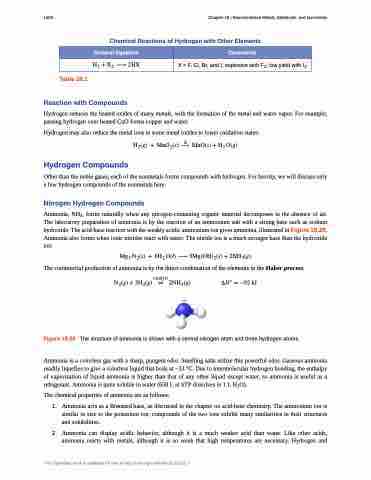Page 1010 - Chemistry--atom first
P. 1010
1000
Chapter 18 | Representative Metals, Metalloids, and Nonmetals
Chemical Reactions of Hydrogen with Other Elements
General Equation
Comments
����� ����
X = F, Cl, Br, and I; explosive with F2; low yield with I2
Table 18.1
Reaction with Compounds
Hydrogen reduces the heated oxides of many metals, with the formation of the metal and water vapor. For example, passing hydrogen over heated CuO forms copper and water.
Hydrogen may also reduce the metal ions in some metal oxides to lower oxidation states:
�
����� � ������� ��� ������ � �� ����
Hydrogen Compounds
Other than the noble gases, each of the nonmetals forms compounds with hydrogen. For brevity, we will discuss only a few hydrogen compounds of the nonmetals here.
Nitrogen Hydrogen Compounds
Ammonia, NH3, forms naturally when any nitrogen-containing organic material decomposes in the absence of air. The laboratory preparation of ammonia is by the reaction of an ammonium salt with a strong base such as sodium hydroxide. The acid-base reaction with the weakly acidic ammonium ion gives ammonia, illustrated in Figure 18.29. Ammonia also forms when ionic nitrides react with water. The nitride ion is a much stronger base than the hydroxide ion:
��� ����� � ��� ���� � ����������� � �������
The commercial production of ammonia is by the direct combination of the elements in the Haber process:
��������
����� � ������ � ������� ��� � ��� ��
Figure 18.29 The structure of ammonia is shown with a central nitrogen atom and three hydrogen atoms.
Ammonia is a colorless gas with a sharp, pungent odor. Smelling salts utilize this powerful odor. Gaseous ammonia readily liquefies to give a colorless liquid that boils at −33 °C. Due to intermolecular hydrogen bonding, the enthalpy of vaporization of liquid ammonia is higher than that of any other liquid except water, so ammonia is useful as a refrigerant. Ammonia is quite soluble in water (658 L at STP dissolves in 1 L H2O).
The chemical properties of ammonia are as follows:
1. Ammonia acts as a Brønsted base, as discussed in the chapter on acid-base chemistry. The ammonium ion is similar in size to the potassium ion; compounds of the two ions exhibit many similarities in their structures and solubilities.
2. Ammonia can display acidic behavior, although it is a much weaker acid than water. Like other acids, ammonia reacts with metals, although it is so weak that high temperatures are necessary. Hydrogen and
This OpenStax book is available for free at http://cnx.org/content/col12012/1.7


